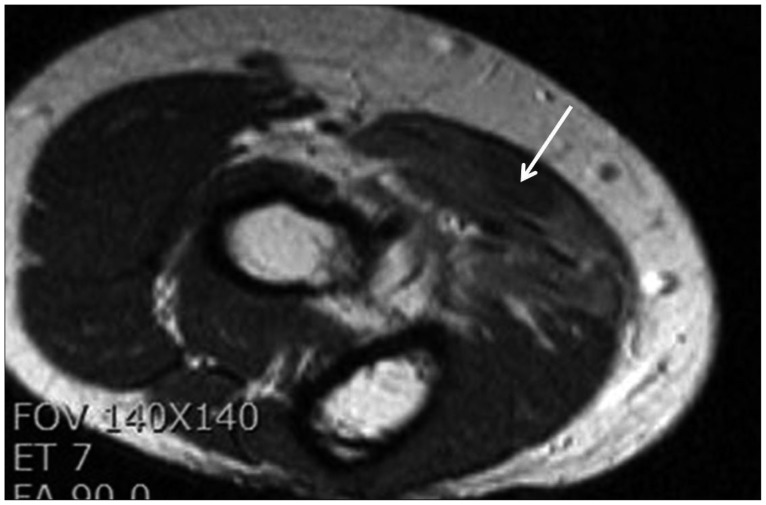J Korean Neurosurg Soc.
2014 May;55(5):296-299. 10.3340/jkns.2014.55.5.296.
Early Surgical Treatment of Pronator Teres Syndrome
- Affiliations
-
- 1Department of Neurosurgery, Incheon, St. Mary's Hospital, The Catholic University of Korea, Suwon, Korea.
- 2Department of Neurosurgery, St. Vincent's Hospital, The Catholic University of Korea, Suwon, Korea. nsman72@hanmail.net
- KMID: 2018039
- DOI: http://doi.org/10.3340/jkns.2014.55.5.296
Abstract
- We report a rare case of pronator teres syndrome in a young female patient. She reported that her right hand grip had weakened and development of tingling sensation in the first-third fingers two months previous. Thenar muscle atrophy was prominent, and hypoesthesia was also examined on median nerve territory. The pronation test and Tinel sign on the proximal forearm were positive. Severe pinch grip power weakness and production of a weak "OK" sign were also noted. Routine electromyography and nerve conduction velocity showed incomplete median neuropathy above the elbow level with severe axonal loss. Surgical treatment was performed because spontaneous recovery was not seen one month later.
MeSH Terms
Figure
Reference
-
1. Bridgeman C, Naidu S, Kothari MJ. Clinical and electrophysiological presentation of pronator syndrome. Electromyogr Clin Neurophysiol. 2007; 47:89–92. PMID: 17479724.2. Buchthal F, Rosenfalck A, Trojaborg W. Electrophysiological findings in entrapment of the median nerve at wrist and elbow. J Neurol Neurosurg Psychiatry. 1974; 37:340–360. PMID: 4829536.
Article3. Gessini L, Jandolo B, Pietrangeli A. Entrapment neuropathies of the median nerve at and above the elbow. Surg Neurol. 1983; 19:112–116. PMID: 6845137.
Article4. Hartz CR, Linscheid RL, Gramse RR, Daube JR. The pronator teres syndrome : compressive neuropathy of the median nerve. J Bone Joint Surg Am. 1981; 63:885–890. PMID: 7240329.5. Jabaley ME, Wallace WH, Heckler FR. Internal topography of major nerves of the forearm and hand : a current view. J Hand Surg Am. 1980; 5:1–18. PMID: 7365209.
Article6. Nigst H, Dick W. Syndromes of compression of the median nerve in the proximal forearm (pronator teres syndrome; anterior interosseous nerve syndrome). Arch Orthop Trauma Surg. 1979; 93:307–312. PMID: 464765.
Article7. Olehnik WK, Manske PR, Szerzinski J. Median nerve compression in the proximal forearm. J Hand Surg Am. 1994; 19:121–126. PMID: 8169356.
Article8. Park IJ, Roh YT, Jeong C, Kim HM. Spontaneous anterior interosseous nerve syndrome : clinical analysis of eleven surgical cases. J Plast Surg Hand Surg. 2013; 47:519–523. PMID: 23627594.9. Seyffarth H. pronator teres as cause of lesion of the N. medianus (the pronator syndrome). Acta Psychiatr Neurol Scand Suppl. 1951; 74:251–254. PMID: 14902580.10. Stutz CM. Neuralgic amyotrophy : Parsonage-Turner Syndrome. J Hand Surg Am. 2010; 35:2104–2106. PMID: 21035964.
- Full Text Links
- Actions
-
Cited
- CITED
-
- Close
- Share
- Similar articles
-
- Topographic Anatomy of the Median Nerve and the Pronator Teres and the Flexor Digitorum Superficialis Muscles
- Partial Tear of Pronator Teres Muscle in Amateur Golfer: A Case Report
- Ligamentum Teres Injury: Anatomy, Biomechanics, Diagnosis and Treatment
- Effect of Forearm Position on the Supination and Pronation Strengths and EMG Activities of Related Muscles
- Rare case of median nerve and brachial artery entrapment by an abnormal musculo-fascial tunnel in the arm: possible cause of neurovascular compression syndrome






